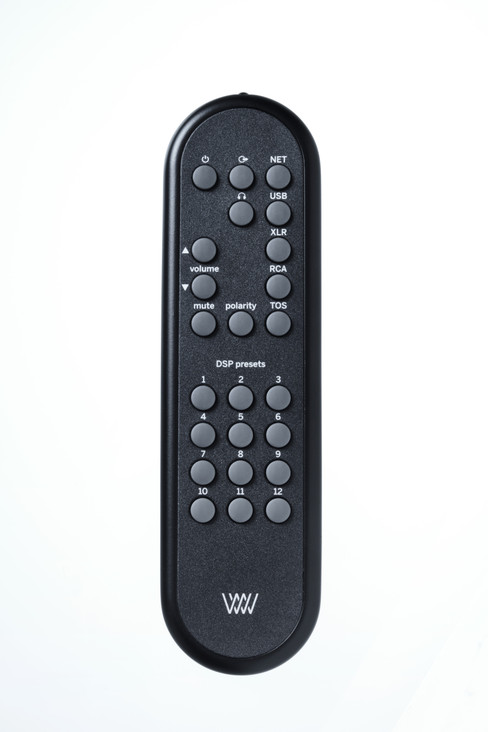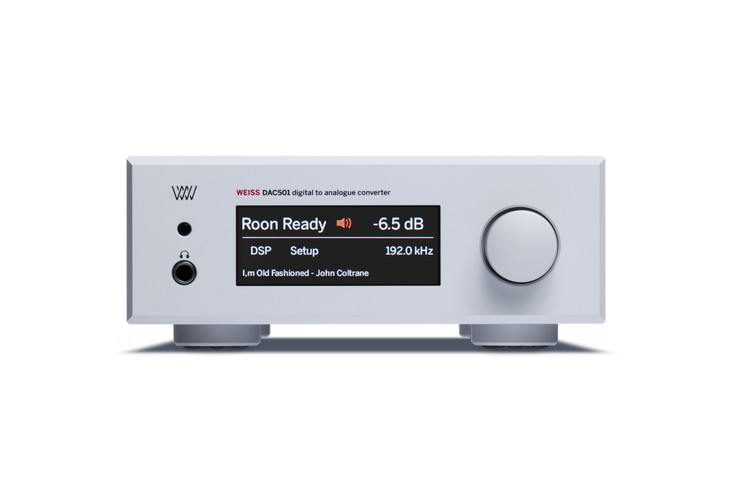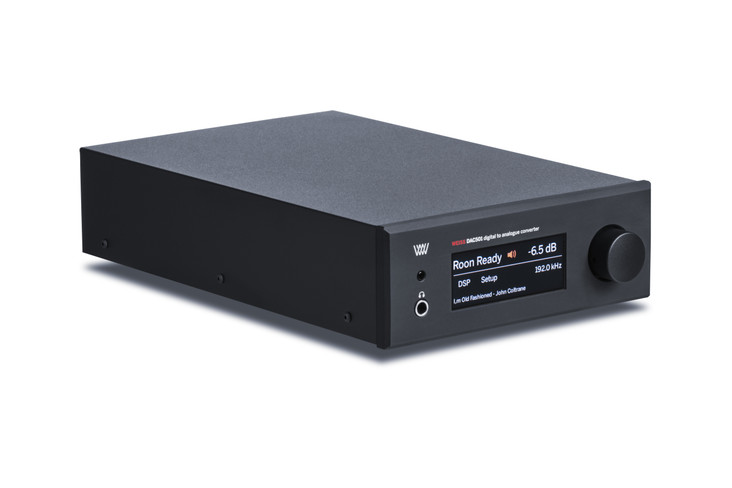Weiss DAC 501
Note: The DAC502 and DAC501 are essentially the same circuit, with only a rear balanced headphone output added to the DAC502. The 502 is the standard component-width model, while the 501 sports a smaller, desktop-friendly chassis.

The Weiss DAC501 and DAC502 represent the pinnacle of development from a Swiss company founded by an original pioneer of digital processing and conversion.
Beyond the vivid, detailed sound of an award-winning digital converter, the finely crafted onboard DSP (Digital Signal Processing) features elevate the DAC's function to another level. Equalization in the digital realm, for instance, is a modern, uncompromising solution to an age-old issue, and owners of a Weiss DAC can take full advantage of the company's years of dominance in this pro-audio specialty.
The Weiss DAC501 and DAC502 aim to be an easy, yet sonically glorious one-box solution, offering advanced streaming capabilities as well. Roon Ready and bit perfect, you just add an amp and speakers (or powered speakers) and you're done.
Or, connect the converter's balanced outputs to your favorite preamplifier and level the volume at 0dB to hear attenuation-free, perfect audio.
Weiss Engineering's 30-year history in the pro audio recording and mastering businesses has taught them a thing or two. They consider the DAC501 and DAC502 to be "The essence of their experiences."
The DAC501-4ch and DAC502-4ch add full 4-channel playback capability along with Weiss’s latest D/A converter for uncompromised performance. Standard DAC501 and DAC502 units can be factory-upgraded to the 4ch versions. Please contact us for more information
Features
- Mechanics
The DAC50x uses a stainless steel chassis with a solid 10 mm aluminium front plate.
- Power Supply
A powerful non-switching power supply is used. All sensitive voltages have their own regulators, which are separated between left and right channels. The result is an analog output free of “digital noise” and channel crosstalk. The power switch activates a semiconductor relay, which only switches on or off at zero crossings of the mains voltage. This assures a glitch-free power switching. The two main transformers are toroidal types. Mains voltage selection is done automatically by measuring the mains voltage before power is applied to the rest of the electronics.
- Synchronization
An internal high-precision / low-jitter clock generator is responsible for clocking the D/A converter section. The sampling frequency of that generator is fixed at about 195kHz. The input signals are converted to the 195kHz sampling frequency for optimal signal quality. This scheme also significantly reduces jitter-related effects. All standard sampling frequencies up to 384 kHz plus DSD x64 and x128 are supported.
- Digital Inputs There are a total of five inputs: AES/EBU or S/PDIF via XLR, Toslink, and RCA sockets.
Future formats for the Weiss can be accommodated via software updates.
- UPnP / DLNA via Ethernet
- USB
- Roon Ready
- Accepted formats: PCM 44.1kHz up to 384 kHz, DSD 64x / 128x.
Signal Processing with the Weiss
The DAC501 has a built-in digital signal processing (DSP) chip. The following DSP algorithms are currently implemented:
- Room Equalizer - targets bass modes, which are the hardest to tame in a room naturally.
- Creative Equalizer - DSP-based tone controls, highly engineered to be transparent. Three bands of audiophile cut or boost are available for fine-tuning.
- De-Essing - be it from the recording, the speakers, or whatever the reason, the surgical de-esser comes in handy from time to time as a subtle tone control.
- Constant Volume-with the "loudness wars" dying down, popular music can be all over the place, volume-wise. This function transparently levels the volume. Ideal for parties or playlists.
- Vinyl Emulation - this feature is pure fun and invokes a real sense of listening to the music on a record.
- Crosstalk Cancelling (XTC) - this unique and handy function allows speaker users to fully enjoy "binaural" recordings that could previously only be experienced with headphones.
- Loudness Control - following the Fletcher/Munson Curves, this tried-and-true function raises treble and bass at low volumes. This compensates for human hearing characteristics at low sound levels.
- Headphone Equalizer - to adapt any headphone to the listener's ears in terms of frequency response.
- Crossfeed - to emulate a speaker-based playback impression on headphones. This can be useful on older recordings with instruments panned hard left or right.
- Converters - two of the latest 32-bit D/A Converter chips are used. Two D/A conversion channels are used per audio channel, resulting in exceptional performance specifications.
Analog Outputs
Line out is unbalanced on the RCA connector.
Line out balanced on XLR connector.
Headphone out on a 1/4" Jack Analogue.
For the DAC502: Additional headphone output on a 4-pin XLR connector.
Discrete output stages are employed for both line and headphone outputs.
The output levels can be set coarsely with four steps to adapt to the amplifier or headphone connected. The levels can be set independently for line and headphone outputs.
No sound-degrading servo mechanisms are used.
Front panel controls
A rotary encoder knob for changing parameters and for powering the unit on/off.
A touch-screen color LCD.
A 1/4 inch headphone socket.
An IR receiver.
Back panel elements
Analog outputs on XLR and RCA connectors.
Digital inputs on XLR, RCA, TOSLINK, USB, and Ethernet connectors.
USB Type A connector for various applications.
Mains connector with fuses.
IR Remote Control
Allows control of several functions of the DAC50x, namely:
The input selected for conversion.
The output type, level, muting, and absolute polarity.
Power on/off.
DSP presets.
Web Interface
The DAC50x has a web interface for configuring it via a web browser. The following functions are accessible via the web interface:
Volume and Balance controls.
Input selection.
Output type.
DSP algorithms configuration.
DSP snapshots configuration.
Specifications
Power
Mains voltage: 100…120 V or 200…240 V, automatic voltage selection
Fuse rating: 500 mA slow blow at 100…120 V, 250 mA slow blow at 200…240 V
Power consumption: 25 VA max.
Power consumption in standby: 2.2 VA max.
Size DAC501
Depth: 30 cm
Width: 18,8 cm
Height: 6,6 cm
Height with feet: 7,2 cm
Size Remote
Depth: 2,1 cm
Width: 4,5 cm
Height: 16,6 cm
Available Color
Silver, Black
Digital Inputs
(1) XLR connector
(1) RCA connector
(1) TOSLINK connector (optical)
(1) USB type B connector
(1) RJ45 Ethernet connector
All inputs accept professional or consumer-standard signals, i.e., AES/EBU or S/PDIFsignals
. Sampling frequencies: 44.1 kHz, 48 kHz, 88.2 kHz, 96 kHz, 176.4 kHz or 192 kHz on any of the inputs. USB and Ethernet also support 352.8 kHz, 384 kHz, DSD64 and DSD128
Maximum input word-length: 24 / 32 Bits
Digital Outputs
none
Analog Outputs
(2) XLR connectors (hot on pin 2), short circuit-proof output circuitry, DC coupled, low output impedance
(2) RCA connectors, short circuit-proof output circuitry, DC coupled, low output impedance
(1) 6.3mm Jack socket for headphones, DC coupled, low output impedance
At the DAC502 only: (1) 4-pin XLR socket for headphones, DC coupled, low output impedance
The output level is selectable via the LCD menu or the web interface; four settings are provided as shown below:
XLR Output with a zero dBFS sine wave input:
0 dB setting: 6.8 Vrms +18.9 dBu
-10 dB setting:
2.2 Vrms +8.9 dBu
-20 dB setting: 0.68 Vrms -1.1 dBu
-30 dB setting: 0.22 Vrms -11.1 dBu
These levels are achieved with a 0.0 dB setting on the LCD screen's level control.
Suggested subsequent amplifier input impedances:
0 dB setting: 900 Ω or higher
-10 dB setting: 100 Ω or higher
-20 dB setting: 60 Ω or higher
-30 dB setting: 60 Ω or higher
RCA Output with a zero dBFS sine wave input:
0 dB setting: 3.4 Vrms +12.9 dBu
-10 dB setting:
1.1 Vrms +2.9 dBu
-20 dB setting: 0.34 Vrms -7.1 dBu
-30 dB setting: 0.11 Vrms -17.1 dBu
These levels are achieved with a 0.0 dB setting on the LCD screen's level control.
Suggested subsequent amplifier input impedances:
0 dB setting: 450 Ω or higher
-10 dB setting: 50 Ω or higher
-20 dB setting: 30 Ω or higher
-30 dB setting: 30 Ω or higher
Headphone Output:
(1) stereo 1/4-inch jack connector, DC coupled. The output level is selectable via the LCD menu; four level settings are provided as shown below:
Headphone output with a zero dBFS sine wave input:
0 dB setting: 6.8 Vrms +18.9 dBu
-10 dB setting:
2.2 Vrms +8.9 dBu
-20 dB setting: 0.68 Vrms -1.1 dBu
-30 dB setting: 0.22 Vrms -11.1 dBu
These levels are achieved with a 0.0 dB setting on the LCD screen's level control.
Suggested headphone impedances:
0 dB setting: 200 Ω or higher
-10 dB setting: 30 Ω or higher
-20 dB setting: 10 Ω or higher
-30 dB setting: 4 Ω or higher
The same parameters apply to the DAC502's four-pin headphone output as well.
Synchronization
Via the input signal in case of the AES/EBU and S/PDIF inputs. Via the internal oscillator in the case of USB and Ethernet inputs
D/A Converter chip
Over-sampling multi-bit sigma-delta converter
Two converters per audio channel
Measurements Main Output
The measurements below have been taken at the following conditions (unless noted otherwise): 1 kHz measurement frequency, maximum selectable output level, 192 kHz sampling frequency (Fs), 22 kHz measurement bandwidth, unweighted, 0 dBr equals the output level at 0 dBFS input.
Frequency Response:
Fs = 44.1 kHz, 0 Hz…20 kHz: within ±0.25 dB
Fs = 88.2 kHz, 0 Hz…20 kHz: within ±0.25 dB
Fs = 88.2 kHz, 0 Hz…40 kHz: within ±0.8 dB
Fs = 176.4 kHz, 0 Hz…20 kHz: within ±0.25 dB
Fs = 176.4 kHz, 0 Hz…40 kHz: within ±0.8 dB
Fs = 176.4 kHz, 0 Hz…80 kHz: within ±2.5 dB
Total Harmonic Distortion plus Noise (THD+N):
-111 dB (0.0003 %) at −3 dBFS input level
-125 dBr (0.000056 %) at −40 dBFS input level
-125 dBr (0.000056 %) at −70 dBFS input level
Linearity:
At zero dBFS to −120 dBFS input level: less than ±0.2 dB deviation from ideal
Spurious components (including harmonics):
At zero dBFS input level, maximum output level, 1 kHz, all components at less than −110 dB
At zero dBFS input level, maximum output level, 4 kHz, all components at less than −110 dB
Crosstalk:
Better than 110 dB, 20 Hz…20 kHz
Interchannel Phase Response:
±0.3° 20 Hz…20 kHz
±0.6° 20 Hz…80 kHz
Awards
- Product of the Year Awards!
- AudioArt - DAC Products of the Year 2020
- SoundStage Pioneering Design Achievement
- 26th Guangzhou AV fair - Best DAC
- MyHiend - Best Innovation Award
- Audiophile/Videophile - Product of the Year
- HiFiReview - Product of the Year
Resources
For more on Weiss Engineering, read:
































